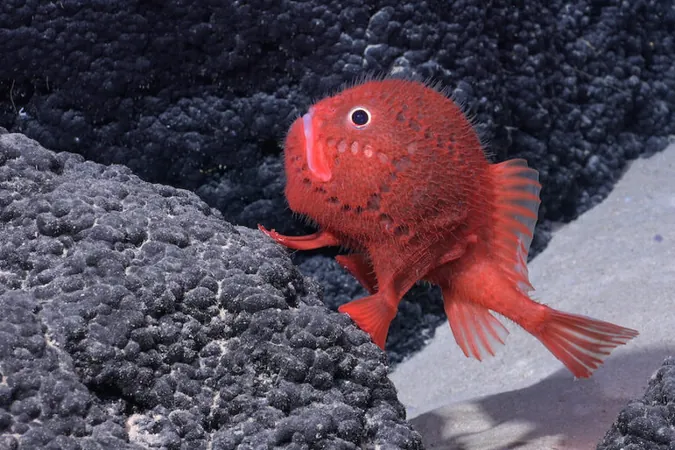
Discovering a Hidden Underwater Paradise: New Species Unveiled!
2024-10-01
Author: Rajesh
In a groundbreaking expedition off the coast of Chile, scientists have stumbled upon an underwater mountain teeming with remarkable biodiversity, unveiling over 100 species potentially new to science. Rare creatures including the whimsical flying spaghetti monster, Casper octopus, and a fish resembling a Muppet highlight this exciting exploration into the depths of the Pacific.
Leading the expedition, Javier Sellanes from Chile’s Catholic University of the North expressed his enthusiasm, stating, "We far exceeded our hopes. The quantity of new species, especially among sponges, is truly astounding." The team ventured through uncharted waters, mapping features along underwater mountain ranges such as the Nazca Ridge and Salas y Gómez Ridge.
A standout discovery was an entirely new seamount, positioned approximately 1,450 kilometers (900 miles) from the Chilean coastline. This underwater mountain, which rises more than 3 kilometers (nearly 2 miles) from the ocean floor, presents an intriguing opportunity for scientific exploration, reaching its summit at a staggering depth of 994 meters (3,261 feet).
This remarkable underwater expedition, which lasted 28 days and took place in July and August, was spearheaded by the Schmidt Ocean Institute alongside Ocean Census and the University of New Hampshire’s Center for Coastal and Ocean Mapping. Utilizing advanced multibeam sonar technology, researchers crafted detailed 3D maps of the seabed and deployed remotely operated underwater vehicles (ROVs) to explore the region’s ecosystems.
Among the thriving deep-sea habitats documented were expansive gardens of ancient corals and vast fields of glass sponges. Remarkably, a pristine coral reef was discovered, spanning approximately 800 square meters (8,600 square feet), showcasing the rich biodiversity that lies beneath the ocean's surface.
"The seamounts of the Southeastern Pacific are home to exceptional biological diversity, with many species never before encountered," stated Alex David Rogers, science director of Ocean Census. The expedition has already expanded the catalog of documented species in this region to over 1,300, a significant increase from just about 1,000 species prior to 2024.
The researchers also made several rare observations, capturing the first-ever footage of a live Promachoteuthis squid—an elusive genus known primarily from historical specimens. The team also encountered the Casper octopus, marking its first sighting in the Southern Pacific, along with two unusual siphonophores, colloquially referred to as flying spaghetti monsters.
This exciting research comes at a pivotal moment as the United Nations recently adopted a high seas treaty aimed at safeguarding biodiversity beyond national jurisdictions. This foundational agreement will potentially lead to the establishment of marine protected areas, enhancing conservation efforts for international waters.
As marine conservationists advocate for greater protection of these critical ecosystems, the urgency of implementing the treaty cannot be overstated. While formal ratification by at least 60 countries is needed for it to take effect, experts like Jeremy Raguain, a Seychellois delegate, express optimism: "This could be a turning point where we unite globally to protect our shared marine heritage."
Andreas Hansen from The Nature Conservancy emphasized the need for proactive measures to ensure that this treaty translates into tangible benefits for the ocean's health. "This is a once-in-a-generation moment,” he remarked, underscoring the collective responsibility to preserve these intricate ecosystems for future generations.
As the treasures of this newfound underwater paradise are slowly unveiled, it puts a spotlight on the importance of future research and conservation efforts dedicated to protecting the mysteries that our oceans hold.




 Brasil (PT)
Brasil (PT)
 Canada (EN)
Canada (EN)
 Chile (ES)
Chile (ES)
 Česko (CS)
Česko (CS)
 대한민국 (KO)
대한민국 (KO)
 España (ES)
España (ES)
 France (FR)
France (FR)
 Hong Kong (EN)
Hong Kong (EN)
 Italia (IT)
Italia (IT)
 日本 (JA)
日本 (JA)
 Magyarország (HU)
Magyarország (HU)
 Norge (NO)
Norge (NO)
 Polska (PL)
Polska (PL)
 Schweiz (DE)
Schweiz (DE)
 Singapore (EN)
Singapore (EN)
 Sverige (SV)
Sverige (SV)
 Suomi (FI)
Suomi (FI)
 Türkiye (TR)
Türkiye (TR)
 الإمارات العربية المتحدة (AR)
الإمارات العربية المتحدة (AR)